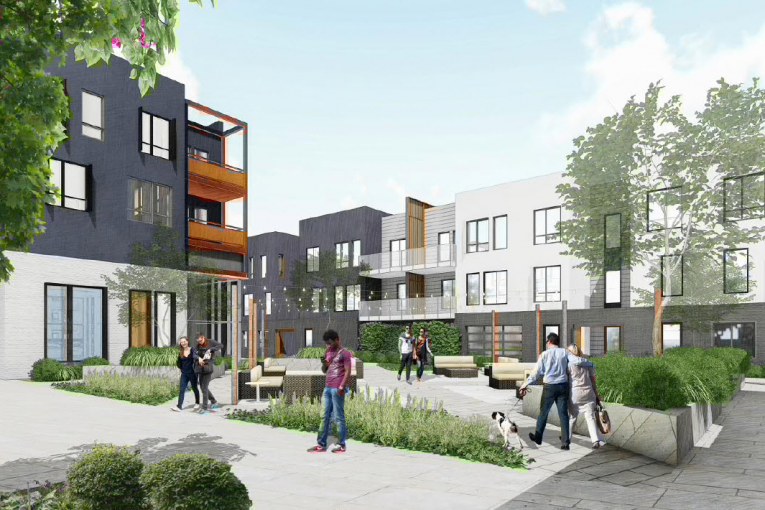

Back in August, the Planning Commission heard the Draft EIR and in November the Social Services Commission heard the affordable housing proposal to redesignate and rezone existing commercial property that previously housed a UC Davis facility along Chiles Road, demolish the existing building, and redevelop the site as a high-density 225-unit apartment project targeting workforce, professional and family housing needs.
In December the Vanguard undertook extensive analysis on the conversion of commercial space to workforce housing. While the Vanguard in January presented city analysis showing a shortage of existing available commercial sites, work by Economic Planning Systems, Inc. (EPS) concluded “the site is not viable for office/R&D/Flex development,” arguing that “it is not located in a larger innovation or research park or district, such as the Interland Research Park (Now University Research Park) or along 2nd Street. The City will be better able to attract new office/R&D/Flex users in available space in these existing or new innovation park/ districts.” (See December analysis).
The Vanguard has noted, as well, that the applicant made concerted efforts to find a commercial use for the property – going as far as engaging Barry Broome from Greater Sacramento Economic Council to find a commercial interest, but, as staff notes, “efforts for adaptive reuse of the existing site have been unsuccessful.”
In the meantime, the city’s economic analysis of multi-family housing prototypes “identified the challenges for this type of development. For the Large Traditional prototype, which is similar to the proposed project, the analysis determined it was marginally feasible even without affordable housing requirements and would be infeasible with affordable housing requirements under the scenarios reviewed.”
The developers take a “different approach” and propose “to create an ongoing contribution to the City’s Housing Trust Fund to help fund the City’s affordable housing programs. The proposal requires an amendment to the Affordable Housing Ordinance, which is being processed concurrently with the subject project…”
Such an amendment would not require review by the Planning Commission but does need approval of the Social Services Commission and City Council.
Overall, “Staff believes that the proposed project would be compatible with the surrounding mix of commercial and residential uses and would enhance the neighborhood. It meets a housing need and provides a housing type, which has not been constructed in the City in recent years, and proposes a new approach to the affordable housing issue.”
In September, the HRMC (Historical Resources Management Commission) met and voted “to recommend that the City Council designate the site a Merit Resource on the Davis Register of Historical Resources (DRHR). The recommendation is based on the eligibility criteria of the existing building’s architectural distinctiveness and significance and the site’s association with the broad patterns of the history of Davis, the commercial development of Yolo County and the City of Davis, and the financial crisis of the late 1980s in California.”
At the same time, the commission “acknowledged in their comments that preservation and adaptive reuse of the site may not be a feasible option.”
On the affordable housing proposal, in its market rate version, the project targets workforce housing by providing studios, one-, two-, and three-bedroom units, which will be rented by the unit.
The result is that it will have fewer bedrooms per unit and thus “higher project costs per unit compared to larger multi-bedroom units.”
The city’s independent fiscal analysis confirmed the belief that “development of the site would not be considered feasible under typical scenarios. The staff believes that the proposed affordable housing plan merits consideration in support of the targeted housing type.”
The proposed plan instead would “devote 1.65 percent of its rental income to the City’s Housing Trust Fund. As such, the program would provide a reliable and growing source of funding once available through the former Davis Redevelopment Agency.”
These funds would exclusively target extremely low, very low, and low income households.
Staff writes, “The actual annual contribution would be determined by project rental income, but in its first year of implementation it is estimated to be $125,000. The annual contribution amount would also be expected to increase over time as rents increase.”
The expectation is that the project would go to the Social Services Commission at their February 25 meeting.
This project meets a growing need in Davis – the need for workforce housing. Staff writes that this development would provide housing types for groups that have been recently underserved, noting that while there have been a number of single-family subdivisions and student-oriented apartments, “no sizeable market-rate apartment projects catering to the local workforce, working professionals, mature singles, or small families have been constructed in the City for some time.”
In running their market tests, they solicit input, and staff notes, “Particularly vocal were owners of businesses ranging from fledgling enterprises to established firms in industries ranging from retail to tech. According to the applicant, these employers see the limited and expensive housing stock in Davis as impediments to attracting and retaining qualified staff.”
Employers and employees alike cite “the existence of a ‘Missing Middle,’ a cohort of middle income residents who earn too much to qualify for below market rate housing, but too little to be able to afford suitable rental housing in Davis. This project begins to fill the demand.”
—David M. Greenwald reporting

I’m generally supportive of a high density project at that site. I’m just curious as to where this 1.65% number comes from. It seems arbitrary. Why aren’t we talking about 5%?
I suspect this comment provides the likely answer.
5% of nothing is still nothing…